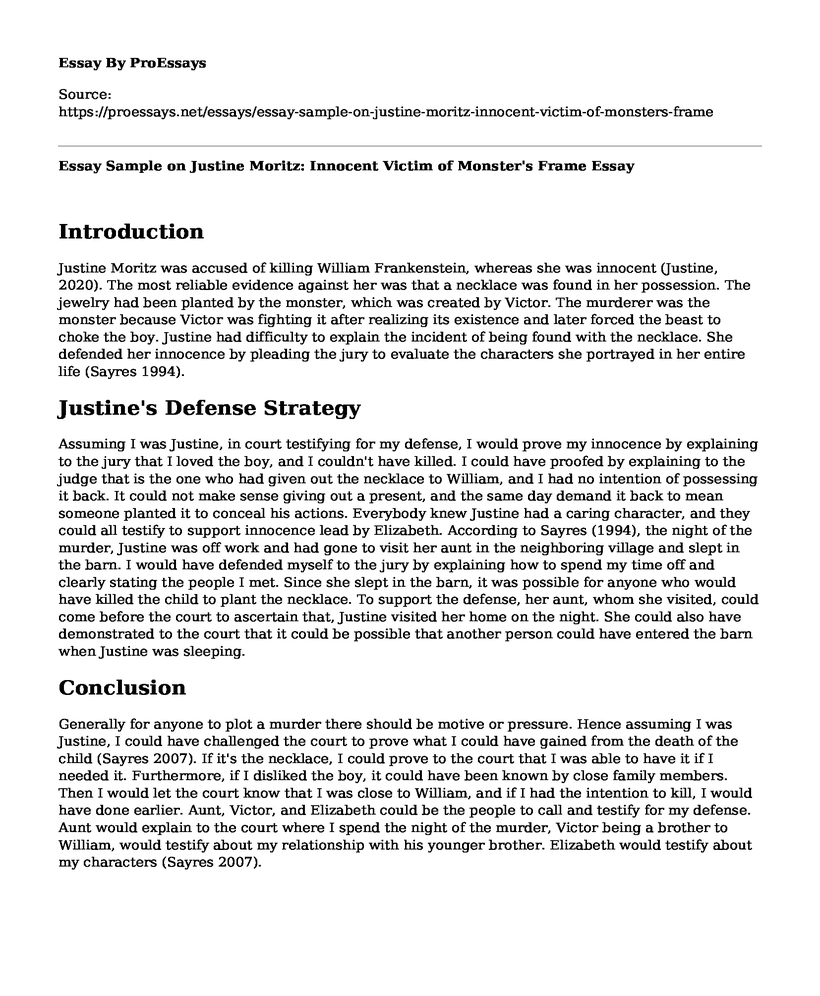Introduction
Justine Moritz was accused of killing William Frankenstein, whereas she was innocent (Justine, 2020). The most reliable evidence against her was that a necklace was found in her possession. The jewelry had been planted by the monster, which was created by Victor. The murderer was the monster because Victor was fighting it after realizing its existence and later forced the beast to choke the boy. Justine had difficulty to explain the incident of being found with the necklace. She defended her innocence by pleading the jury to evaluate the characters she portrayed in her entire life (Sayres 1994).
Justine's Defense Strategy
Assuming I was Justine, in court testifying for my defense, I would prove my innocence by explaining to the jury that I loved the boy, and I couldn't have killed. I could have proofed by explaining to the judge that is the one who had given out the necklace to William, and I had no intention of possessing it back. It could not make sense giving out a present, and the same day demand it back to mean someone planted it to conceal his actions. Everybody knew Justine had a caring character, and they could all testify to support innocence lead by Elizabeth. According to Sayres (1994), the night of the murder, Justine was off work and had gone to visit her aunt in the neighboring village and slept in the barn. I would have defended myself to the jury by explaining how to spend my time off and clearly stating the people I met. Since she slept in the barn, it was possible for anyone who would have killed the child to plant the necklace. To support the defense, her aunt, whom she visited, could come before the court to ascertain that, Justine visited her home on the night. She could also have demonstrated to the court that it could be possible that another person could have entered the barn when Justine was sleeping.
Conclusion
Generally for anyone to plot a murder there should be motive or pressure. Hence assuming I was Justine, I could have challenged the court to prove what I could have gained from the death of the child (Sayres 2007). If it's the necklace, I could prove to the court that I was able to have it if I needed it. Furthermore, if I disliked the boy, it could have been known by close family members. Then I would let the court know that I was close to William, and if I had the intention to kill, I would have done earlier. Aunt, Victor, and Elizabeth could be the people to call and testify for my defense. Aunt would explain to the court where I spend the night of the murder, Victor being a brother to William, would testify about my relationship with his younger brother. Elizabeth would testify about my characters (Sayres 2007).
References
Justine Moritz. (2020). Retrieved 5 April 2020, from https://www.cliffsnotes.com/literature/f/frankenstein/character-analysis/justine-moritz
Moritz in Frankenstein. English language notes, 31(4), 48-54. https://pascal-francis.inist.fr/vibad/index.php?action=getRecordDetail&idt=3724476
Sayres, P. (2007). "This Wretched Mockery of Justice": Mary Shelley's Frankenstein and Geneva Sayres, W. G. (1994). Compounding the crime: ingratitude and the murder conviction of Justine. European Romantic Review, 18(5), 645-661. https://www.tandfonline.com/doi/abs/10.1080/10509580701757243
Cite this page
Essay Sample on Justine Moritz: Innocent Victim of Monster's Frame. (2023, May 09). Retrieved from https://proessays.net/essays/essay-sample-on-justine-moritz-innocent-victim-of-monsters-frame
If you are the original author of this essay and no longer wish to have it published on the ProEssays website, please click below to request its removal:
- Theme of Insecurity in This Boys Life by Tobias Wolff
- A Literary Essay Sample: Value of Transparency and Vices of Secrecy in The Circle
- Is Hamlet's Madness Truly Feigned or Does He Cross into True Insanity?
- The Portrayal of Human Love in the Poem Lady Mary Wroth's Pamphilia to Amphilanthus
- The Theme of Moral Corruption in The Great Gatsby Novel: Critical Essay
- Essay on Danger for Odysseus
- Uncovering the Universe's Greater Truth - Essay Sample







